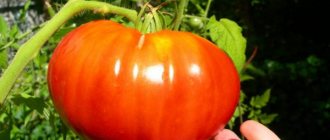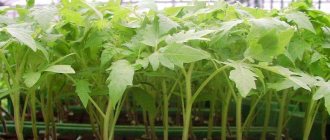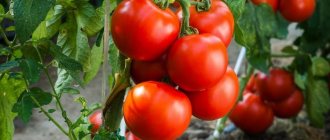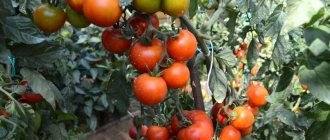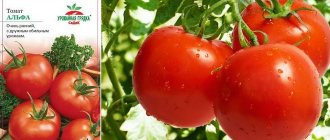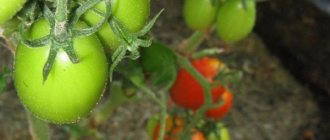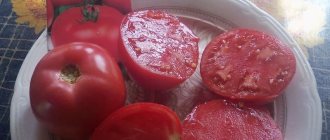The Katrina tomato variety is classified as an early-ripening hybrid. Reviews from gardeners confirm the high yield and emphasize the excellent resistance of plants to unfavorable environmental conditions.
The Katrina tomato variety is not at all difficult to grow; it grows both in greenhouses and in open ground. According to reviews and photos of summer residents, it can be argued that the plant has a rich yield, the fruits are medium in size and are used in the preparation of various dishes.
Characteristics and description of the variety
The Katrina tomato is an early-ripening determinate variety, the plant weight is no more than 120 cm. Under favorable environmental conditions, proper cultivation and care, the ripening of the first tomato fruits may be as early as 85 days after emergence.
The main advantage of this tomato variety is its high yield. At the end of summer, you can get up to 5 kg of medium, round tomatoes from one bush.
The height of a tomato bush varies from 60 cm to 120 cm, depending on growing conditions and territorial features.
As for diseases, the plant is resistant and has excellent immunity. It tolerates temperature changes normally and the fruits are not prone to cracking and spoiling, which is an important advantage for storage and marinades.
The general characteristics of the Katrina tomato variety are as follows:
- The bushes are of medium size and height, bushiness is moderate. The leaves are rich green and small.
- The stem is strong, which allows the plant to withstand unfavorable environmental conditions.
- Tomatoes of this variety are resistant to temperature changes.
- The plant has significant immunity to many diseases.
- The tomato does not need careful care.
- The fruits of the vegetable are regular, neat in shape, rich red in color. Up to 7 ovaries are formed on one bush. The surface of the fruit is smooth, the skin is thin and does not crack.
- Katrina tomatoes are versatile in use. They are used to prepare dishes, salads and marinades.
Interesting! The weight of one fruit reaches 150–200 grams.
Harvesting and application
Early ripening fruits ripen quickly and smoothly . If the branches are tied, then harvesting is not difficult. Ripe vegetables are tasty and juicy, so they are great for fresh salads, hot and vegetable dishes, slices and various snacks. They are also good in canning, pickles and marinades. They make excellent juices, pastes, adjika and sauces.
Thanks to their durable skin and dense pulp, tomatoes can be transported over any distance without losing their presentation.
Advantages and disadvantages
The main advantages of the Katrina tomato variety are:
- Excellent yield.
- The plant is unpretentious to grow and does not require careful care.
- The fruits are medium in size, suitable for storage, almost do not crack and have good taste.
- Tomatoes can be grown both in a greenhouse and in open ground.
- The plant has increased resistance to major dangerous diseases.
- Tomato growth is average, so you can care for it without any problems.
- The tomato plant tolerates temperature changes well.
According to reviews from summer residents, no significant shortcomings were identified.
OUR FAVORITE TOMATOES
Our Natural Farming Center always has a large assortment of different seeds. But the greatest attention, of course, is always paid to tomatoes. My eyes are wide open from such a choice! Tomatoes are probably our favorite crop in the Urals. It is grown both on the street and in a greenhouse, and many manage to grow it at home on the balcony. And of course, every gardener has his own favorite, reliable varieties, which they grow from year to year. But you always want to try something new. Many summer residents have become a habit of trying new interesting varieties every year. I decided to try it, and several of them at once.
I want to tell you about some varieties of tomatoes that I remember and liked the most this season.
Tomato Koenigsberg red
The variety is mid-season, excellent for growing both in open ground and in film greenhouses. The plant is indeterminate, very tall up to 2 meters. The yield of the variety is excellent, the weight of the tomato reaches 300g.
Tomato Koenigsberg golden
Similar to its brother, only smaller and tastier, because the orange-colored varieties are rich in beta-carotene. I really liked it, it grew in a greenhouse and ripened on the vine.
Tomato O-la-la
A very powerful tall plant. Smooth, large, 5-6 tomatoes per bunch. The yield from the bush is high. I recommend.
Tomato Honey Drop
It is written on the package that it will not be high, in the greenhouse it was made at 2m. There were not as many clusters of fruit as we would have liked. The taste of the fruit is actually honey. I liked it.
Tomato Big Beef F 1
Hybrid, smooth and beautiful, hung like a Christmas tree with large tomatoes up to 300g. They last a long time and do not spoil. The bush was tall and powerful and did not suffer from anything. Meaty and delicious. Such tomatoes are better suited for ketchup, tomato paste and juice, and for salad.
All these tomatoes grew in a greenhouse, forming a bush into one stem. Natural farming methods were used.
Tomato Emerald apple
The variety is green-fruited, salad type. Delicious, meaty. Of course, it won’t last long, but it’s possible to grow a curiosity – it’s unusual.
Tomato Grandma's secret
It was declared as tall, but in open ground it showed itself to be short - medium height up to 1 m. The harvest was surprising. Very large, heavy, sugary. On one brush there are from 4 to 5 large 400g. fruits
Tomato Mushroom Basket
Medium-sized, in open ground it formed 2 stems. Its unusual shape is easily recognizable. It is large, almost 400g, ribbed, has no hollow chambers, and is bright red. Just right for a salad.
Tomato Torbay F 1
Hybrid. It grows well in open ground. Carpal type. 5-6 fruits. Strong, healthy. I liked you always wake up with tomatoes.
Tomato Katrina F1
This is a variety from the Gardens of Russia. Stocky, bright juicy greens. There are a lot of fruits on the brush, all of them are smooth, round, and red, just like the selection. They lie well, the skin is dense, because they are hybrids.
French grape tomato
Suitable not only for greenhouses but also for open ground. A medium-sized tomato strewn with clusters. There are a lot of fruits, the weight of a tomato is up to 100g, but the taste is a little disappointing, hard and not sweet, the chambers are empty and not filled with pulp. Suitable for pickling.
Tomato Chio-chio-san
Low-growing bush, produces many stepsons. There are a lot of fruits, all oval, bright red, tasty. Universal.
Tomato Karotinka
Medicinal, orange, not large, same as in the picture, very tasty and children will like it. The bush is low-growing, neat. One bush is enough. Fruitful.
I grew all these tomatoes in open ground. The warm bed was prepared in the fall. I planted it in the ground at the end of the first ten days of June, without shelter. The ground was mulched with old sawdust all season. This year, the TsPZ store has already updated the assortment of tomatoes. Of course, I will try new varieties. I wish you great harvests of interesting experiments, and find YOUR tomato!
Soil preparation
An important step on the path to an excellent tomato harvest is the correct choice of soil. It is believed that any variety of tomato is quite demanding in the choice of soil; it must be breathable, light and preferably sandy loam. You should also maintain an optimal acidity level. Preparing the soil for planting the Katrina tomato begins in the fall. At this time, the ground is dug up and the necessary mineral and organic fertilizers are added. In the spring, soil treatment is repeated. It is dug up again and, if necessary, enriched with additional fertilizers.
To plant tomato seeds, select a ready-made soil mixture or you can prepare the substrate yourself. To do this, humus, wood ash and sawdust, superphosphate and earth are mixed in certain quantities. The finished mixture is laid out in special containers and the seeds are sown for seedlings.
Note! You should use various fertilizers very carefully, since a large amount of them can be harmful. Therefore, be sure to read the instructions and follow them carefully.
Sowing tomato seeds
Tomato seeds of the Katrina variety begin to be sown approximately 60 days before the plants are planted in the ground. Sowing is carried out in special disposable plastic containers or boxes. All containers must have small holes at the bottom so that normal gas exchange occurs and there is no stagnation of liquid in the soil.
Before planting, the seeds are disinfected with a weak solution of potassium permanganate and checked for fruiting by placing them in a glass of water. Those specimens that remain at the bottom are allowed for cultivation.
The soil is thoroughly moistened with lukewarm water. Medium shallow furrows are made in the ground and seeds are placed in them infrequently. Sprinkle the top with soil and lightly compact it.
After planting, carry out basic care methods as necessary. Some gardeners advise covering containers with cling film until the first shoots appear in order to maintain optimal temperature, humidity and lighting.
Interesting! Treatment of seeds with growth preparations will help speed up the germination of seedlings.
How to grow seedlings
Many varieties are grown in seedlings and the Katrina tomato is no exception. It will not be possible to collect seed material on your own, since the crop is hybrid.
Seed preparation
As a rule, before releasing seed for sale, the manufacturer takes care of the quality of the product. Therefore, purchased seeds are not disinfected; they are already disinfected and ready for sowing. But to improve germination, grains are soaked in a growth stimulator for 10 hours. As soon as the seeds swell, they are sown in the ground.
Reference. Most often, the drug “Epin” or melt water is used as a stimulant.
Container and soil
The soil is prepared from garden soil mixed with humus and wood ash in equal quantities. Superphosphate is added to the resulting mixture as fertilizer. After thorough mixing, the soil is steamed in the oven at a temperature of 50 ° C for 15 minutes or spilled with a hot solution of potassium permanganate. In this way, pathogenic flora is destroyed.
Reference. Self-prepared soil is subject to mandatory disinfection. Pathogenic spores contained in the soil can cause irreparable harm to young plants.
After the soil has cooled, it is laid out in planting containers, filling them halfway. Subsequently, as the seedlings grow, soil is poured into containers, providing the necessary nutrition throughout the entire seedling period.
You can plant in a common wooden box and in separate cups: plastic or peat. Peat cups are considered an ideal option for growing seedlings, since the seedlings do not need to be picked and transplanted into the soil from a container - the seedlings are lowered into the holes along with the cup. This is due to the fact that the tomato tolerates picking and transplanting too painfully, and then takes a long time to take root in the new conditions.
Important! Picking and replanting will delay fruiting dates
Sowing
Seeds are sown 2 months before planting in the ground. They are buried 1 cm with a distance of 2 cm from each other. Sprinkle soil on top and lightly compact. Moisten with warm, settled water from a spray bottle and cover with film to create greenhouse conditions.
After this, the seeded containers are left in a bright and warm room at a temperature of 22–24 °C. At temperatures below 18 °C, seedlings will appear later and seedlings will noticeably lag behind in development.
Seedling care
When seedlings appear, the containers are placed on the windowsill, but not in direct sunlight, otherwise the young bushes will get burned.
Water moderately from a shallow watering can with warm, settled water. There is no need to flood the sprouts; excess moisture will not be beneficial, but, on the contrary, will have a negative effect on the root system. After watering, the soil is loosened with a wooden stick. This improves the air permeability of the soil.
When growing seedlings in a common container, they must be picked after the appearance of two true leaves. It should be replanted into a separate container together with a large lump of earth, having first moistened the soil well. Otherwise, the seedlings will take a long time to take root after picking. With weak growth, seedlings are fed with liquid fertilizer for tomato seedlings.
Two weeks before planting in the ground, seedlings are hardened off in the open air at a temperature of at least 16 °C. Initially, the time spent on the street is no more than one hour, then it is increased to 9–11 hours. The night temperature in the room is reduced to 13 °C.
Transplanting seedlings into soil
When the tomato seedlings of the Katrina variety have grown sufficiently, become stronger and at least 6-7 true leaves have formed on the stem, they can be transplanted into open ground or a greenhouse.
Tomato transplantation is carried out as follows:
- The entire plot of land is dug up, and fertilizers are applied again as necessary.
- Dig holes in a row. An interval of 30-40 cm is left between the bushes, and about 50 cm between the rows.
- Seedlings are immersed in the ground up to almost half their length.
- The top of the hole is sprinkled with dry soil and watered with water at room temperature.
Note! To transplant the Katrina tomato, you need to choose clear, warm weather.
Rules of care
The Katrina tomato variety is not particularly demanding in care; the plant tolerates temperature changes well and has increased resistance to dangerous underlying diseases.
Caring for tomatoes involves watering, mulching, weeding and loosening the holes, applying fertilizers, as well as controlling pests and diseases.
You should start loosening and weeding the beds 10-12 days after transplanting the seedlings. It is also recommended to regularly dig up the soil after watering.
For better growth and development of tomato plants, fertilizers should be applied 3 times per season. These can be both mineral and organic compounds. Some gardeners advise sprinkling the soil near the stem with wood ash to protect the plant from pests.
Watering is carried out regularly as needed, as soon as the soil dries out. It is advisable to take water at room temperature or a little warmer. The liquid output is up to 1 liter per well.
The fight against diseases and pests is carried out through pollination of plants with special preparations, as well as through proper and timely care.
How to grow tomatoes
Transplantation is carried out as soon as 6–7 true leaves are formed on the bushes , and the soil warms up to 15 ° C. The soil is prepared in the fall - it is dug up and a complex of mineral fertilizers is applied.
Landing
In spring, the soil is dug up again two weeks before transplanting. The holes are made no deeper than 20 cm and a little superphosphate is placed at the bottom of each. Replant in clear weather in the evening after sunset.
Planting pattern : 40 cm is the distance between seedlings, 50 cm is left between rows. For 1 sq. m place no more than six plants.
The holes are covered with earth and watered with warm, settled water . The plants get used to the new place within ten days. During this time, they are not watered or fed, since all the seedlings’ efforts are aimed at adaptation.
Further care for the Katrina tomato
Tomato does not require close attention and complex agricultural technology . Proper care comes down to regular moderate watering and timely application of fertilizing.
Regular watering is established as the seedlings take root in a permanent place . Water as the top soil layer dries out, without flooding the plants. The water is settled and heated in large barrels exposed to the sun, since the hybrid does not like cold water.
After watering, the soil is loosened and hilled up to improve oxygen access to the roots . To keep the beds moist longer, they are mulched. The culture responds well to drip irrigation. To do this, place a plastic bottle without a bottom in the root system and fill it with water.
The minimum amount of fertilizing is three times throughout the entire season . The fertilizer is a complex of mineral compounds or organic matter. It is not recommended to feed the crop with fresh manure, due to which the green mass increases without the formation of ovaries. From organic matter, use mullein infusion or bird droppings in a ratio of 1:15.
During flowering, boric acid is added to the fertilizer, and during fruiting, potassium salts are added.
Features of care and possible difficulties
When grown in open ground, the crop does not require pinching or bush formation. This significantly facilitates care during the growing season.
Despite the determinate type, the plant requires obligatory gartering of the stem and fruit-bearing branches . With timely fixation to the support, the stem is formed strong and even, making it much easier for it to withstand the weight of the ovaries. As they grow, fruit-bearing branches are fixed to the support, otherwise the fruits may rot if they come into contact with wet beds.
Read also: Planting thujas for hedges
The lower leaves up to the first fruiting cluster are removed for the same reason, so that they do not come into contact with wet soil. Rotting foliage will lead to the spread of fungal diseases.
Diseases and pests
Prevention is carried out if peppers or potatoes are planted next to the tomato . These crops belong to the same family, suffer from the same diseases and are affected by the same pests.
The Colorado potato beetle, whitefly and aphids are dangerous for tomatoes. A soap solution used to treat the plant stem will get rid of aphids, and the drug “Prestige” will be used to get rid of the Colorado potato beetle. But if there are few pests, a thorough inspection of each seedling will help. The beetle is collected by hand along with its larvae.
The whitefly is a butterfly that causes damage directly to the leaves , causing them to wither and fall off. To combat it, pheromone traps are placed next to the seedlings and strong-smelling herbs are planted. The smell of such herbs repels not only whiteflies, but also other pests.
Reference. Pheromone traps capture only pests without causing any harm to other insects.
To prevent fungal diseases, seedlings are sprayed with copper-containing preparations or a manganese solution. They also use Fitosporin, which helps not only in prevention, but also in the fight against the disease.
Diseases and pests
The Katrina tomato variety is characterized by excellent disease resistance. However, if the cultivation and care techniques are violated, spotting, mosaic, any types of rot, late blight and other diseases can develop. As a result, the green part of the vegetable and the fruits themselves are affected, up to the complete death of the plant.
Pests also often appear on tomatoes. More often, their occurrence is caused by growing tomatoes near nightshade crops, peppers or potatoes, which have similar diseases.
Pests can include aphids, mole crickets, whiteflies, slugs and wireworms.
